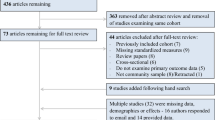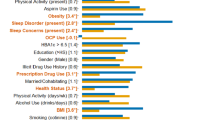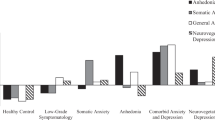Abstract
In recent years, a replication crisis in psychiatry has led to a growing focus on the impact of researchers’ analytic decisions on the results from studies. Multiverse analyses involve examining results across a wide array of possible analytic decisions (e.g., log-transforming variables, number of covariates, or treatment of outliers) and identifying if study results are robust to researchers’ analytic decisions. Studies have begun to use multiverse analysis for well-studied relationships that have some heterogeneity in results/conclusions across studies.We examine the well-studied relationship between peripheral inflammatory markers (PIMs; e.g., white blood cell count (WBC) and C-reactive protein (CRP)) and depression severity in the large NHANES dataset (n = 25,962). Specification curve analyses tested the impact of 9 common analytic decisions (comprising of 58,000+ possible combinations) on the association of PIMs and depression severity. Relationships of PIMs and total depression severity are robust to analytic decisions (based on tests of inference jointly examining effect sizes and p-values). However, moderate/large differences are noted in effect sizes based on analytic decisions and the majority of analyses do not result in significant findings, with the percentage of analyses with statistically significant results being 46.1% for WBC and 43.8% for CRP. For associations of PIMs with specific symptoms of depression, some associations (e.g., sleep, appetite) in males (but not females) were robust to analytic decisions. We discuss how multiverse analyses can be used to guide research and also the need for authors, reviewers, and editors to incorporate multiverse analyses to enhance replicability of research findings.
This is a preview of subscription content, access via your institution
Access options
Subscribe to this journal
Receive 13 print issues and online access
$259.00 per year
only $19.92 per issue
Buy this article
- Purchase on Springer Link
- Instant access to full article PDF
Prices may be subject to local taxes which are calculated during checkout


Similar content being viewed by others
References
Baker M. Reproducibility crisis. Nature. 2016;533:353–66.
Steegen S, Tuerlinckx F, Gelman A, Vanpaemel W. Increasing transparency through a multiverse analysis. Perspect Psychological Sci. 2016;11:702–12.
Simonsohn U, Simmons JP, Nelson LD. Specification curve: Descriptive and inferential statistics on all reasonable specifications. Available at SSRN 2694998. 2019.
Lonsdorf T, Gerlicher A, Klingelhöfer-Jens M, Krypotos A-M. Multiverse analyses in fear conditioning research. Behaviour Research and Therapy. 2021;153:104072.
Botvinik-Nezer R, Holzmeister F, Camerer CF, Dreber A, Huber J, Johannesson M, et al. Variability in the analysis of a single neuroimaging dataset by many teams. Nature. 2020;582:84–8.
Majd M, Saunders EF, Engeland CG. Inflammation and the dimensions of depression: a review. Front Neuroendocrinol. 2020;56:100800.
Horn SR, Long MM, Nelson BW, Allen NB, Fisher PA, Byrne ML. Replication and reproducibility issues in the relationship between C-reactive protein and depression: a systematic review and focused meta-analysis. Brain Behav Immun. 2018;73:85–114.
Yuan N, Chen Y, Xia Y, Dai J, Liu C. Inflammation-related biomarkers in major psychiatric disorders: a cross-disorder assessment of reproducibility and specificity in 43 meta-analyses. Transl Psychiatry. 2019;9:1–13.
Moriarity DP, Horn SR, Kautz MM, Haslbeck JM, Alloy LB. How handling extreme C-reactive protein (CRP) values and regularization influences CRP and depression criteria associations in network analyses. Brain Behav Immun. 2021;91:393–403.
White J, Kivimäki M, Jokela M, Batty GD. Association of inflammation with specific symptoms of depression in a general population of older people: the English Longitudinal Study of Ageing. Brain Behav Immun. 2017;61:27–30.
Michal M, Wiltink J, Kirschner Y, Wild PS, Münzel T, Ojeda FM, et al. Differential associations of depressive symptom dimensions with cardio-vascular disease in the community: results from the Gutenberg health study. PLoS One. 2013;8:e72014.
Gialluisi A, Di Castelnuovo A, Bracone F, De Curtis A, Cerletti C, Donati MB, et al. Associations between systemic inflammation and somatic depressive symptoms: findings from the Moli‐sani study. Depress Anxiety. 2020;37:935–43.
O’Connor M-F, Bower JE, Cho HJ, Creswell JD, Dimitrov S, Hamby ME, et al. To assess, to control, to exclude: effects of biobehavioral factors on circulating inflammatory markers. Brain Behav Immun. 2009;23:887–97.
Rengasamy M, Da Costa E, Silva SA, Spada M, Price RB. Does the moderator matter? Identification of multiple moderators of the association between peripheral inflammatory markers and depression severity in a large racially diverse community cohort. Neuropsychopharmacology. 2022;47:1693–701.
NHANES, National Center for Health Statistics. National Health and Nutrition Examination Survey. 2021. Centers for Disease Control and Prevention website, NHANES, National Center for Health Statistics; 2021. https://www.cdc.gov/nchs/nhanes/index.htm.
Milaneschi Y, Kappelmann N, Ye Z, Lamers F, Moser S, Jones PB, et al. Association of inflammation with depression and anxiety: evidence for symptom-specificity and potential causality from UK Biobank and NESDA cohorts. Molecular Psychiatry. 2021;26:7393–402.
Moriarty AS, Gilbody S, McMillan D, Manea L. Screening and case finding for major depressive disorder using the Patient Health Questionnaire (PHQ-9): a meta-analysis. Gen Hospital Psychiatry. 2015;37:567–76.
Riniolo TC, Porges SW. Evaluating group distributional characteristics: Why psychophysiologists should be interested in qualitative departures from the normal distribution. Psychophysiology. 2000;37:21–8.
Knief U, Forstmeier W. Violating the normality assumption may be the lesser of two evils. Behav Res Methods. 2021;53:2576–90.
Changyong F, Hongyue W, Naiji L, Tian C, Hua H, Ying L. Log-transformation and its implications for data analysis. Shanghai Arch Psychiatry. 2014;26:105.
Wright L, Head JA, Jivraj S. How robust is the association between youth unemployment and later mental health? An analysis of longitudinal data from English schoolchildren. Occup Environ Med. 2021;78:618–20.
Harder JA. The multiverse of methods: extending the multiverse analysis to address data-collection decisions. Perspect Psychological Sci. 2020;15:1158–77.
Moore MJ, Demeyere N. Multiverse to inform neurological research: an example using recovery outcome of neglect. J Neurol. 2022;269:233–42.
Schäfer T, Schwarz MA. The meaningfulness of effect sizes in psychological research: differences between sub-disciplines and the impact of potential biases. Front Psychol. 2019;10:813.
Szucs D, Ioannidis JP. Empirical assessment of published effect sizes and power in the recent cognitive neuroscience and psychology literature. PLoS Biol. 2017;15:e2000797.
Modecki KL, Low‐Choy S, Uink BN, Vernon L, Correia H, Andrews K. Tuning into the real effect of smartphone use on parenting: a multiverse analysis. J Child Psychol Psychiatry. 2020;61:855–65.
Barendse ME, Byrne ML, Flournoy JC, McNeilly EA, Guazzelli Williamson V, Barrett A-MY, et al. Multimethod assessment of pubertal timing and associations with internalizing psychopathology in early adolescent girls. J Abnormal Psychol. 2021;131:14.
Mac Giollabhui N, Ng TH, Ellman LM, Alloy LB. The longitudinal associations of inflammatory biomarkers and depression revisited: systematic review, meta-analysis, and meta-regression. Mol Psychiatry. 2020;26:3302–14.
Schisterman EF, Cole SR, Platt RW. Overadjustment bias and unnecessary adjustment in epidemiologic studies. Epidemiology. 2009;20:488.
Lewis MW, et al. Multiverse analyses of fear acquisition and extinction retention in posttraumatic stress disorder. Psychophysiology. 2023:e14265.
Bloom PA, VanTieghem M, Gabard‐Durnam L, Gee DG, Flannery J, Caldera C, et al. Age‐related change in task‐evoked amygdala—prefrontal circuitry: a multiverse approach with an accelerated longitudinal cohort aged 4–22 years. Hum Brain Mapp. 2022;43:3221–44.
Black L, Panayiotou M, Humphrey N. Internalizing symptoms, well-being, and correlates in adolescence: a multiverse exploration via cross-lagged panel network models. Dev Psychopathol. 2022;34:1477–91.
El Bahri M, Wang X, Biaggi T, Falissard B, Naudet F, Barry C. A multiverse analysis of meta-analyses assessing acupuncture efficacy for smoking cessation evidenced vibration of effects. J Clin Epidemiol. 2022;152:140–50.
Olsson-Collentine A, van Aert R, Bakker M, Wicherts J. Meta-analyzing the multiverse: A peek under the hood of selective reporting. Psychol Methods. 2023. https://psycnet.apa.org/fulltext/2023-71132-001.html.
Simmons JP, Nelson LD, Simonsohn U. False-positive psychology: Undisclosed flexibility in data collection and analysis allows presenting anything as significant. Psychological Sci. 2011;22:1359–66.
Fanelli D. Do pressures to publish increase scientists’ bias? An empirical support from US States Data. PloS One. 2010;5:e10271.
Okura Y, Urban LH, Mahoney DW, Jacobsen SJ, Rodeheffer RJ. Agreement between self-report questionnaires and medical record data was substantial for diabetes, hypertension, myocardial infarction and stroke but not for heart failure. J Clin Epidemiol. 2004;57:1096–103.
Moriarity DP, Kautz MM, Mac Giollabhui N, Klugman J, Coe CL, Ellman LM, et al. Bidirectional associations between inflammatory biomarkers and depressive symptoms in adolescents: Potential causal relationships. Clin Psychological Sci. 2020;8:690–703.
Xue Y, Liu G, Geng Q. Associations of cardiovascular disease and depression with memory related disease: a Chinese national prospective cohort study. J Affect Disord. 2020;266:187–93.
Bondy E, Norton SA, Voss M, Marks RB, Boudreaux MJ, Treadway MT, et al. Inflammation is associated with future depressive symptoms among older adults. Brain Behav Immun Health. 2021;13:100226.
Manfro PH, Anselmi L, Barros F, Gonçalves H, Murray J, Oliveira IO, et al. Youth depression and inflammation: Cross-sectional network analyses of C-Reactive protein, interleukin-6 and symptoms in a population-based sample. J Psychiatric Res. 2022;150:197–201.
Frank P, Jokela M, Batty GD, Cadar D, Steptoe A, Kivimäki M. Association Between Systemic Inflammation and Individual Symptoms of Depression: A Pooled Analysis of 15 Population-Based Cohort Studies. Am J Psychiatry. 2021;178:1107–18.
Pitharouli MC, Hagenaars SP, Glanville KP, Coleman JR, Hotopf M, Lewis CM, et al. Elevated C-reactive protein in patients with depression, independent of genetic, health, and psychosocial factors: results from the UK Biobank. Am J Psychiatry. 2021;178:522–29.
Lee S, Oh SS, Jang S-I, Park E-C. Sex difference in the association between high-sensitivity C-reactive protein and depression: the 2016 Korea National Health and Nutrition Examination Survey. Sci Rep. 2019;9:1–10.
Manea L, Gilbody S, McMillan D. Optimal cut-off score for diagnosing depression with the Patient Health Questionnaire (PHQ-9): a meta-analysis. CMAJ. 2012;184:E191–6.
Tracy M, Morgenstern H, Zivin K, Aiello AE, Galea S. Traumatic event exposure and depression severity over time: results from a prospective cohort study in an urban area. Soc Psychiatry Psychiatr Epidemiol. 2014;49:1769–82.
Khandaker GM, Zuber V, Rees J, Carvalho L, Mason AM, Foley CN, et al. Shared mechanisms between coronary heart disease and depression: findings from a large UK general population-based cohort. Mol Psychiatry. 2020;25:1477–86.
Linkas J, Ahmed LA, Csifcsak G, Emaus N, Furberg A-S, Grimnes G, et al. Are pro-inflammatory markers associated with psychological distress in a cross-sectional study of healthy adolescents 15–17 years of age? The Fit Futures study. BMC Psychol. 2022;10:1–13.
Cong X, Tracy M, Edmunds LS, Hosler AS, Appleton AA. The relationship between inflammatory dietary pattern in childhood and depression in early adulthood. Brain Behav Immun Health. 2020;2:100017.
Burrows K, Stewart JL, Kuplicki R, Figueroa-Hall L, Spechler PA, Zheng H, et al. Elevated peripheral inflammation is associated with attenuated striatal reward anticipation in major depressive disorder. Brain Behav Immun. 2021;93:214–25.
Stewart JC, Rand KL, Muldoon MF, Kamarck TW. A prospective evaluation of the directionality of the depression–inflammation relationship. Brain Behav Immun. 2009;23:936–44.
Raison CL, Rutherford RE, Woolwine BJ, Shuo C, Schettler P, Drake DF, et al. A randomized controlled trial of the tumor necrosis factor antagonist infliximab for treatment-resistant depression: the role of baseline inflammatory biomarkers. JAMA Psychiatry. 2013;70:31–41.
Lamers F, Milaneschi Y, Smit JH, Schoevers RA, Wittenberg G, Penninx BW. Longitudinal Association Between Depression and Inflammatory Markers: Results From the Netherlands Study of Depression and Anxiety. Biol Psychiatry. 2019;85:829–37.
Tayefi M, Shafiee M, Kazemi-Bajestani SMR, Esmaeili H, Darroudi S, Khakpouri S, et al. Depression and anxiety both associate with serum level of hs-CRP: a gender-stratified analysis in a population-based study. Psychoneuroendocrinology. 2017;81:63–9.
Bai Y-M, Chiou W-F, Su T-P, Li C-T, Chen M-H. Pro-inflammatory cytokine associated with somatic and pain symptoms in depression. J Affect Disord. 2014;155:28–34.
Schmidt FM, Schröder T, Kirkby KC, Sander C, Suslow T, Holdt LM, et al. Pro-and anti-inflammatory cytokines, but not CRP, are inversely correlated with severity and symptoms of major depression. Psychiatry Res. 2016;239:85–91.
Birur B, Amrock EM, Shelton RC, Li L. Sex differences in the peripheral immune system in patients with depression. Front Psychiatry. 2017;8:108.
Köhler-Forsberg O, Buttenschøn HN, Tansey KE, Maier W, Hauser J, Dernovsek MZ, et al. Association between C-reactive protein (CRP) with depression symptom severity and specific depressive symptoms in major depression. Brain Behav Immun. 2017;62:344–50.
Funding
This research was supported by funding from the Ruth L. Kirschstein National Research Service Award Institutional Research Training Grants sponsored by the National Institutes of Health (Grant No. NIH T32 MH018951: Brent).
Author information
Authors and Affiliations
Contributions
Author MR contributed to all aspects of the manuscript, including conceptualization, study design, data curation, data analysis, data interpretation and writing. Authors DM, TK, BT, and RP contributed to conceptualization, data interpretation and writing.
Corresponding author
Ethics declarations
Competing interests
The authors declare no competing interests.
Additional information
Publisher’s note Springer Nature remains neutral with regard to jurisdictional claims in published maps and institutional affiliations.
Supplementary information
Rights and permissions
Springer Nature or its licensor (e.g. a society or other partner) holds exclusive rights to this article under a publishing agreement with the author(s) or other rightsholder(s); author self-archiving of the accepted manuscript version of this article is solely governed by the terms of such publishing agreement and applicable law.
About this article
Cite this article
Rengasamy, M., Moriarity, D., Kraynak, T. et al. Exploring the multiverse: the impact of researchers’ analytic decisions on relationships between depression and inflammatory markers. Neuropsychopharmacol. 48, 1465–1474 (2023). https://doi.org/10.1038/s41386-023-01621-4
Received:
Revised:
Accepted:
Published:
Issue Date:
DOI: https://doi.org/10.1038/s41386-023-01621-4



